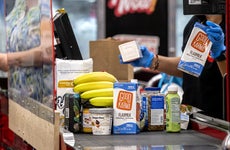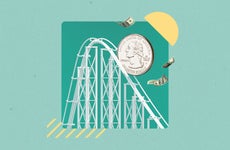Red-hot inflation is raising prices on everyday essentials — here’s what’s rising the most

The Bankrate promise
At Bankrate we strive to help you make smarter financial decisions. While we adhere to strict , this post may contain references to products from our partners. Here's an explanation for .
The average gallon of milk costs nearly a dollar more today than it did two years ago. A dozen eggs is up almost $1.50. Gasoline in June hit its highest price per gallon on record.
Inflation is hitting the items Americans need most hardest — making the hottest price pressures in 40 years almost impossible to avoid.
“One of the difficult aspects of the inflation we’ve been seeing over the past year is that it’s been coming in categories that are not discretionary,” says Christine Benz, director of personal finance at Morningstar. “It’s hit all of us, and there’s no getting around it.”
That was certainly true in a March Bankrate poll. Americans almost unanimously (at 93 percent) said they had noticed inflation, with 81 percent seeing it at the grocery store and 73 percent noticing it at the gas pump. Almost 3 in 4 (or 73 percent) said they were worried about new or continued price increases on everyday essentials over the next year, the survey also found.
Meanwhile, adults who earned less than $30,000 (at 37 percent) were almost twice as likely than earners making above $100,000 a year (at 22 percent) to have been “very negatively” impacted by inflation.
Altogether, inflation is costing the average American an extra $460 per month, according to an analysis from Ryan Sweet, senior director of economic research at Moody’s Analytics.
Mitigating the impact you feel from inflation starts first with tracking how expensive items have become. To help, Bankrate analyzed price increases over the past 12 months on a basket of 50 consumer staples from the Bureau of Labor Statistics’ Consumer Price Index (CPI). Those staples included utility services, transportation costs, gasoline, groceries, personal care products, health care and more.
Here’s what’s getting the most expensive as well as tips for reducing how much you pay as prices rise by the fastest rate many Americans have ever seen.
From groceries to gasoline, here’s where prices are rising the most
Inflation is making almost every item consumers buy more expensive, but there are clear places where price pressures are salient: Food and energy.
Groceries: Eggs, chicken, milk
In fact, 6 of the 10 most inflated items in Bankrate’s consumer staples analysis were grocery food items: eggs (32 percent), butter and margarine (20 percent), chicken (17 percent), citrus fruits (16 percent), milk (16 percent) and coffee (15 percent).
Food prices are increasing at a faster pace than the broader CPI, according to the Bureau of Labor Statistics. The agency’s two grocery indexes — the first reflecting food and the second reflecting cooking ingredients such as spices, sugars, fats and oils — rose by 11.9 percent (the fastest since April 1979) and 12.6 percent (the biggest jump since January 1981), respectively, over the past year. Those price increases eclipsed the cost of eating a meal out at a restaurant, which jumped 9 percent over the past year, though still the biggest annual increase on record.
The index for dairy and related products more broadly rose 11.8 percent, the largest annual increase since April 2008, according to the CPI. Chicken’s jump was the largest year-over-year increase on record.
Shopping around and finding replacements — the long-running advice for combating inflation — is an even greater challenge as almost every food item gets more expensive.
Meat prices, for instance, jumped nearly 12 percent over the past year, with increases in pork (13 percent), fish and seafood (12 percent) and beef and veal (10 percent). Even fruits and vegetables, at 8 percent, saw broad-based jumps — from apples (6 percent), bananas (6 percent), potatoes (9 percent) and lettuce (11 percent).
Amid supply shortages impacting formula, baby food is up about 13 percent from 12 months ago.
Energy: Gasoline and some utilities
Gasoline prices climbed almost 50 percent from a year ago, the most of any item and among the fastest pace of increases since 2010. More broadly, the category contributed almost 2 percentage points to CPI’s 8.6 percent annual gain in May.
That wasn’t the only corner within energy that grew more expensive. Energy costs within the home also climbed over the past 12 months, with utility-piped gas service soaring 30 percent and energy services touching 16 percent.
Water, sewer and trash collection services rose 4 percent from a year ago, while cable and satellite television services rose about 6 percent, the biggest increases since December 2018 and October 2017, respectively.
A separate measure of household energy from the Bureau of Labor Statistics jumped 19 percent, the sharpest increase since February 2006. Fuels and utilities more broadly jumped 16 percent, the biggest move since July 2008.
Those increases have implications for almost every facet of consumer life — not just prices at the pump or your monthly utility bills.
A major consequence of high gasoline prices: It becomes even less economical to travel and check prices at different places.
“If you’re looking for food bargains and need to go to two or three grocery stores, that’s extra gas in many cases,” Morningstar’s Benz says. “You can inadvertently add to your gas bill while trying to control your food inflation.”
Not to mention, almost every other industry uses energy — and when those costs get more expensive, they’re often passed along to consumers.
Why are food prices still high? A lot if it has to do with energy prices. It’s pervasive in how we get food delivered to us and how it is grown.
— John LaForgeHead of Real Asset Growth, Wells Fargo Investment Institute
Other factors are also at play, including broader forces of supply and demand. A major culprit was Russia’s invasion of Ukraine, which affected global supply. The price of a barrel of oil has nearly doubled since the war began, according to the U.S. Energy Information Administration.
Yet, that’s only contributed an extra 15 percent to the recent increases in oil prices, LaForge estimates. Even before Russia invaded Ukraine, oil and gasoline prices were surging. In January 2022, the average price of a gallon of unleaded gasoline was $3.41 — almost a dollar more than it was in February 2020, according to the Bureau of Labor Statistics.
Simply put, oil producers slowed production as the world shut down due to the coronavirus pandemic — and they’ve been slow to resume production as the world reopened.
“The tide went out and everyone said, ‘Oh, wait a minute, we don’t have enough supply,” LaForge says. “You basically need a long runway of money and time to get to the point where we’re producing enough for humanity. That’s why you’re probably going to see prices pick back up again next year.”
The good news is that not all utilities are climbing at as fast a pace. Prices on wireless telephone services dropped by almost a full percentage from a year ago.
Personal care — and not just for people
Prices on many personal care items — including for pets — haven’t climbed this fast since 2009. Pet products, including food and supplies, rose about 8 percent from a year ago, while personal care products have risen nearly 3 percent.
Medical care is up 4 percent from a year ago, while health insurance jumped almost 14 percent, both the biggest increases since September 2020.
Rent
One worrisome aspect of inflation: rent. While rent’s near 5 percent increase might seem modest compared to other categories, it’s the biggest increase since February 1987 and has charted a rapid ascent.
It’s troubling because it’s an aspect of inflation that tends to linger in Americans’ wallets for longer. As long as they’re locked in a lease, Americans are subjected to those higher prices.
“With food, energy, and shelter prices continuing to escalate at the fastest pace in decades, any relief for household budgets remains elusive,” says Greg McBride, CFA, Bankrate chief financial analyst.
6 steps to fight back against high inflation
The silver lining: Food and energy prices tend to be volatile, largely reflecting supply and demand. Americans could eventually feel some reprieve once supply chain bottlenecks ease, meaning the prices of those consumer staples could cool quicker than other categories, such as services and rent.
That, however, takes time. Here are six steps Americans should consider taking with their wallet in the meantime.
1. Check for sales and discounts — or ways you can earn money back
The most important lesson to remember in a high-inflationary environment is that every penny counts.
Shopping around might be a tall task amid broad-based inflation, but some retailers still offer discounts. That’s already happening at places like Walmart, Target, and Gap Inc., especially on bigger-ticket items such as furniture and televisions.
Consider planning your meals around what food is on sale, while also utilizing technology in whatever way you can to spot deals. That could be using the internet to find a cash-back credit card that rewards you for grocery store or gas purchases, price checking online as much as possible to prevent you from having to drive from place to place and signing up for a loyalty program with your local grocery store. Many such programs offer members additional discounts.
2. Track your budget and limit big-ticket purchases
High inflation makes prudent, everyday financial steps even more essential. Tracking where your money goes from month to month is another important step, particularly to figure out how sensitive you are to inflation. You might be able to see clear ways where inflation is hitting your wallet — especially if you notice that an item you frequently buy (but don’t need) has recently increased. Consider eliminating it from your budget right away.
Some consumer staples might also be less essential than you think. You might find a better deal by switching to a different cable or satellite television provider — if you judge that it’s a necessary expense at all. Trimming away at all of the different subscriptions you have could help make room in your budget. A separate Bankrate poll from February found that more than half of Americans (or 51 percent) with a subscription or membership account had been hit with an unwanted charge at some point.
3. Look at yard sales or resale items
You might be able to avoid inflation for specific items altogether by shopping hyperlocal for the goods you want. Take advantage of resale groups in your area, whether those are online or around your neighborhood. Americans are also parting with their items for free in online groups such as the “Buy Nothing Project” amid the highest inflation in 40 years.
Those items are a strong counter against inflation because you’re not buying from a company with profit margins. Instead, consumers are often just trying to rehome an unwanted item. Even better, try to negotiate and haggle with the individual you’re buying from, another important route to limiting how much you spend.
The reverse could also work if you’re trying to part with unwanted items and make extra cash during today’s red-hot levels of inflation.
4. Negotiate for a raise and take advantage of today’s historically strong job market
Even as worries about a recession mount, jobseekers still have most of the power in today’s labor market. Joblessness is at a near half-century low, applications for unemployment insurance have stabilized and employers have added nearly half a million jobs each month on average over the past year.
Take advantage of companies’ intense demand for new labor (there are almost 2 job openings per every unemployed worker) by negotiating for a raise or cost-of-living adjustment. Even more impactful, data shows that job switchers tend to see the biggest pay gains, if you can find a new position that suits your needs and lifestyle. If you already customized your inflation rate, you might have a better idea of what you need to earn to at least break even.
“If you haven’t had that conversation with your employer or your employer hasn’t talked to you about helping you keep up with rising prices, it’s a good idea to raise that issue,” Morningstar’s Benz says. “That’s one thing that working people have going for them: We are in a very strong job market. Employees have a lot of negotiating power.”
Even if you’re unable to get a raise that beats today’s 8.6 percent headline inflation rate, working out a flexible work arrangement with your employer could help you save even more money and limit your exposure to inflation — especially if you’re able to work from home. Remote work could help limit your commute times and how much money you spend for gas, a major cost-saving strategy right now.
5. Don’t be afraid to look for help
Americans could be eligible for resources at both the federal and local level that could help them a lot if their budget is feeling stretched by high inflation.
Consider applying for food stamps if you’re eligible or utilizing the child and dependent care tax credit to help offset the cost of rising child care.
You might also qualify for two federal utility assistance programs if your state elected to use them: the Low-Income Home Energy Assistance Program (LIHEAP) or the Department of Energy’s Weatherization Assistance Program (WAP).
Be sure to keep in contact with your individual utility providers. They could also offer you an individualized assistance program or payment plan.
6. Keep saving — but find the best place to park your cash
A high-inflation era might seem like a poor time to keep cash on the sidelines, but it’s actually all the more important, especially as recession fears rise. Another economic risk, the Federal Reserve is raising interest rates to hopefully cool price pressures — but there’s a chance that they might not get it right, tipping the financial system into a downturn.
Online banks tend to offer savings accounts with yields nearly 10 times the national average, providing another way to limit how much inflation eats away at your money as you continue to build up your rainy day fund. Shop around for the best high-yield savings account that suits your needs.
Bottom line
Inflation endangers Americans’ wallets, impacting larger swaths of the population than even joblessness. There aren’t many places consumers and businesses can hide from inflation, but there are important steps that they can take to at least blunt the blow until price pressures eventually — and hopefully — alleviate.
“The effects of high and sustained inflation are much more pernicious than unemployment in the sense that high prices affect more people,” says Mark Hamrick, Bankrate senior economic analyst. “The cost of basics is increasingly out of reach for many.”
Related Articles

Top high-yield savings accounts are now beating inflation. Here’s why that’s important

Inflation is slowing, but prices are still uncomfortably high — here’s what’s driving it

Even after inflation cools, Americans could still be paying the price

Inflation is crushing Americans’ savings — here’s 6 tips to protect your money